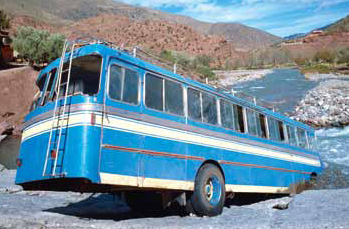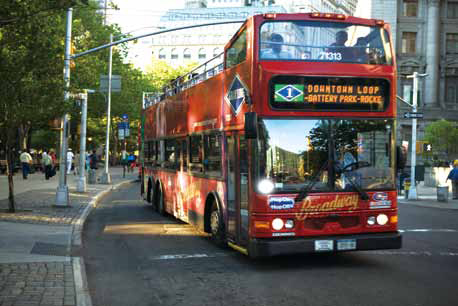Adaptation
 While the functionality of a general-purpose DVR and a mobile DVR may be similar, it is not a case where copy and paste is the wisest decision. It is more like rewriting a novel into a movie, where different use cases create different possibilities and limitations. The main difference between a regular DVR and a mobile DVR lies in the environments in which they are meant to serve, said Dererk Dai, R&D Manager for Hi Sharp Electronics. According to Qin, five factors define an adequate mobile solution: power supply, anti-vibration mechanism, dust prevention, heat dissipation and data transmission.
While the functionality of a general-purpose DVR and a mobile DVR may be similar, it is not a case where copy and paste is the wisest decision. It is more like rewriting a novel into a movie, where different use cases create different possibilities and limitations. The main difference between a regular DVR and a mobile DVR lies in the environments in which they are meant to serve, said Dererk Dai, R&D Manager for Hi Sharp Electronics. According to Qin, five factors define an adequate mobile solution: power supply, anti-vibration mechanism, dust prevention, heat dissipation and data transmission.
As mobile DVRs can only be located on the vehicle, power supply must be drawn from the vehicle as well. “This creates an unstable supply of power. Electronics are sensitive to power surges and spikes, and equipment fails quickly if this is not handled properly,” Qin said. “In addition, mobile DVRs also act as a hub that stabilizes power for sensors, cameras and other peripherals. Some manufacturers use lower-quality power supplies to contain costs, but this inevitably shortens the life span of their products.”
Since vehicles are constantly in motion, vibration is inevitable. Constant vibration leads to mechanical failure if this is not accounted for during design. One of the factors that sets products apart is the materials used for anti-vibration mechanisms, Qin said. “While rubber may be used to lower production costs, it deteriorates over time. Generally, rubber guarantees performance in short time frames but is susceptible to heat and cold, which softens or hardens the rubber. Higher-end products use wire rope, which ensures performance regardless of external factors. However, the higher cost is passed down to the user.”
Mobile DVRs are generally installed in confined compartments. This exacerbates the problem of heat dissipation because mobile DVRs require long operation hours. “The challenge here is twofold. If you try to fit in fans to the DVR, you will inevitably leave an opening in the enclosure and make it more vulnerable to dust. Therefore, fans are not acceptable for mobile DVRs, and alternative means must be considered,” Qin said.
"Aluminum is the preferred material for enclosures as it allows heat to dissipate even when it is completely sealed. Low-cost products may use aluminum alloys instead of pure aluminum to control costs, but they will be incapable of handling dust and heat properly.”
Transmission was the weakest link for many mobile DVRs, but this has changed due to advances in wireless technologies. “Previously, innovation in mobile DVRs was slow as the limited transmission options constrained how manufacturers could add value for users. Even Wi-Fi was not as significant as some thought it would be because of its short range. The availability of 3-G networks has enabled a wide variety of new functions and use cases,” Qin said. For example, previously it was not practical to transmit data collected from the vehicle in real time, such as video, location, brake signals, speed and inertial measurements.
Wireless
 With the advent of 3-G networks, mobile DVRs have begun to transition to IP-based systems and HD video, Qin said. “This is more apparent with rail applications. Rail applications involve larger compartments , and security staff needs to see even small details clearly. The demand for network cameras in this space has risen dramatically in the past two years.”
With the advent of 3-G networks, mobile DVRs have begun to transition to IP-based systems and HD video, Qin said. “This is more apparent with rail applications. Rail applications involve larger compartments , and security staff needs to see even small details clearly. The demand for network cameras in this space has risen dramatically in the past two years.”
Light rail/MRT is another fast adopter of IP-based technologies for high-bandwidth communications such as video and wireless and cellular networking, Dilber added. “The main driver for this has been the fixed routing of these platforms, which enables much more accurate uploading and downloading of video, audio, metadata and custom content for advertising, public address and similar nonsecurity applications.”
Buses generally do not need network cameras, as there is less demand on image resolution and analog cameras are sufficient, Qin said. “In China, long-range shuttles are required by law to install mobile surveillance systems. Although the number of cameras is not specified by regulators, the front and rear views must be recorded at all times. Typically, public buses need four channels, while extended tourist shuttles require six and two-deck shuttles eight."
woes
However, innovations enabled by advances in wireless technologies are uneven in different geographies, mainly due to different cost structures, Dilber said. “3-G+ pricing plans make certain high-bandwidth applications prohibitive in the U.S. and Europe, while extremely attractive in certain Asian markets.”
Wireless streaming of video over a WAN network is nice to have, but this is still cost-prohibitive in most jurisdictions, Simmons said. “Generally, wireless video management and downloading are only cost-effective using wireless LAN, such as Wi-Fi. WAN-based wireless is still too expensive for transmitting large amounts of video that is generated by a four-channel system.”
However, this will change in time as data costs continue to drop. “It may become possible to stream video back to a central server instead of storing it locally on the vehicle,” Simmons said. “We think that this is many years away, but it is definitely a trend to be watched.”
As wireless networks are spotty, it makes sense to invest more in this space to maintain reliable transmission channels. “Proper specification of robust Wi-Fi technologies that are industrial grade rather than consumer grade, coupled with proper network design and coverage at the bus yard or depot, can minimize problems,” Simmons said.
"A comprehensive site survey of the wireless environment will mitigate the majority of headaches that come with wireless systems. A site survey, combined with comprehensive checklists and small-scale proofing of the system with live vehicles before full deployment, is the key to success for the end user,” Dilber said.
Location-Bas ed Advertising
The market for mobile DVRs is still fairly underdeveloped, and the distinction between software and hardware is not as clearly defined as it is for fixed security systems. “This is not as well-established as it is in the fixed security space, and therefore, most of the sales revenue is tied to hardware,” Simmons said.
This is an opportunity to explore new sources of revenue, as an established platform provides added value to the end user, Dai said. For instance, IP-based technologies can be utilized to transform the mobile DVR to a central hub for transmitting all types of data back to the headquarters or a server, Qin added.
Location-based technologies and advertising appear to be a match made in heaven, and yet current solutions seem underwhelming. “From a DVR manufacturer 's perspective, this has been more hype than reality. Most security-centric DVR manufacturers offer capabilities but do not have the ecosystem of partners (advertising sales, content providers) to capitalize on this opportunity,” Dilber said.
The main challenge in developing such a platform is that it is no longer about a single device, or even integration between devices, Qin said.
"However, there is strong demand from customers for this functionality. We expect fleet managers to be able to recoup their investments from such a system in no more than six months. In China, the development of location-based advertising systems for public transportation is accelerating and will gain wide adoption within the next two years, as the 3-G networks mature and 4-G networks debut.”